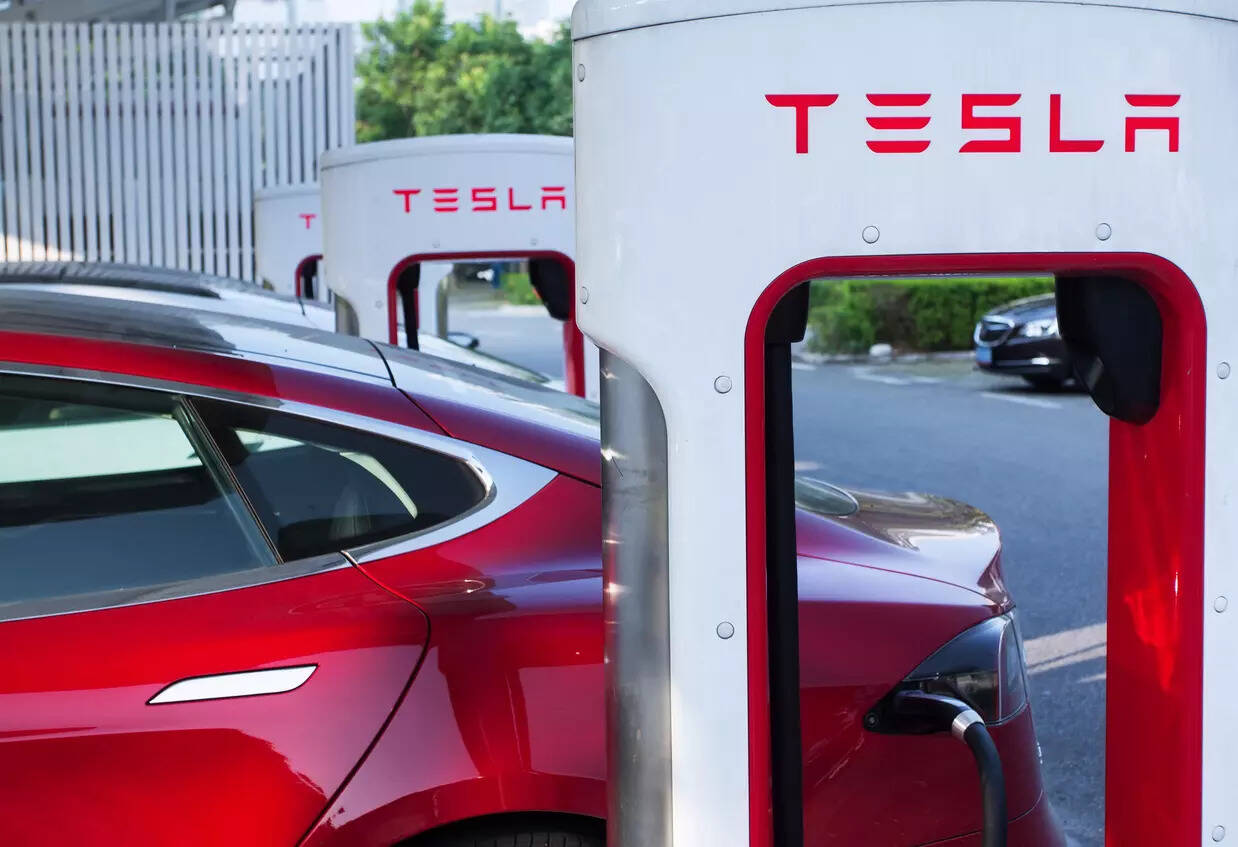
From the availability of Tesla’s Superchargers to the readiness of India’s power grid, several million-dollar questions now take centrestage. With the EV giant officially entering the Indian market, marked by the grand opening of its first showroom at Jio World Drive in BKC, Mumbai – attention turns to what EV infrastructure exists in the country, what must be built, and how much strain this will place on an already overburdened power grid.
Tesla’s India website already lists the Model Y for Indian customers, promising supercharge in 15 minutes – up to 238 kilometres for its rear wheel drive, and up to 267 kilometres for its long-range rear wheel drive. Though it mentions that the said is dependent on factors such as Supercharger type, vehicle configuration, state of charge, battery temperature, speed, weather and elevation change, among others. It also outlines the early Supercharger network under development, including planned locations in Mumbai (BKC, Navi Mumbai, Thane), Gurugram, Delhi Aerocity, and Noida.
“For markets like India where CCS2 (Combined Charging System / IEC 62196-3) dominates, Tesla has developed connector adapters or dual-compatible systems to ensure that even their NACS-based (North American Charging Standard) models can charge from existing infrastructure for the LR RWD model. This strategic flexibility highlights a broader industry shift towards interoperability and charging standard unification, ensuring greater accessibility and convenience for EV users across India,” shares Arun Handa, CTO, Servotech Renewable Power System. This is highly relevant given that Tesla has confirmed the launch of two models in India Model Y RWD, which supports CCS2 charging, and Model Y LR RWD, which uses Tesla’s proprietary North American Charging Standard (NACS).
Charging Infrastructure Challenge
For the Model Y RWD, Tesla can fully leverage India’s existing network of CCS2-based fast chargers, available across highways, cities, and commercial zones. This alignment ensures minimal infrastructure investment and a faster market rollout. However, the Model Y LR RWD with NACS presents a unique challenge, as India currently lacks any NACS-based infrastructure. “To support this, Tesla would either need to develop proprietary superchargers or offer reliable CCS2-to-NACS adapters. This would require additional investment and could affect scalability in the short-term,” says Handa. Currently, Tesla is offering connectors for the LR RWD models to charge from the existing EV charging infrastructure in India and Tesla’s wall mount chargers for quicker at home charging.
For now, aligning with India’s CCS2 standard enables Tesla to accelerate market entry, reduce deployment costs, and ensure a smoother user experience for Indian EV buyers while they build a charging infrastructure for the NACS supported vehicles.
Currently, CCS2 standard chargers are commonly used for four-wheelers and hybrid EVs in India, and are capable of fast DC charging up to 360 kW. It’s an extension of the IEC 62196 Type 2 connector, with additional DC pins for high-power delivery.
“The CCS2 charger type is already available in India and used by brands such as Tata Motors, JSW MG Motor, Mahindra & Mahindra, Mercedes-Benz, BMW, and Audi,” says Kwan Wongwetsawat, Senior Analyst – Global Powertrain, Automotive at GlobalData.
Fast Charging Gap
“Over 90 per cent of India’s public fast charging network uses CCS2, ensuring compatibility with Tesla’s global vehicle architecture. However, a large portion of the current installed base consists of DC chargers in the 30–60 kW range, which offer limited charging speed for a Tesla-sized battery. That said, CPOs (Charging Point Operators) in India are actively expanding into higher-power chargers (120–240 kW), particularly on highways and urban hubs. Tesla will likely address ultra-fast charging needs by installing its own hyper-chargers at high-traffic or premium locations, and partnering with major Indian CPOs to co-develop ultra-fast charging points that can serve its vehicles,” says Anshuman Divyanshu, CEO – EV, Exicom.
“Post initial traction and market validation (in 18–24 months), Tesla may evaluate deeper investment, including a dedicated Supercharger network, depending on demand, policy clarity, and competitive dynamics,” he adds.
Tesla’s adoption of CCS2 in Europe and ASEAN aligns well with India’s direction. “Tesla typically establishes its own charging stations, known as Tesla Superchargers, when entering new markets, often restricted to Tesla vehicles only,” notes Wongwetsawat. “Tesla’s CCS2 is identical to that used in Europe, Thailand, Malaysia, and Singapore. In contrast, Tesla’s proprietary NACS is limited to the US, Canada, and Japan.”
According to Krishna K Jasti, CEO & CPO of EVRE, “The Indian EV space is significantly adaptive. Tesla’s entry will positively impact the scalability of the overall industry. With CCS connectors already embedded in India’s infrastructure, we are equipped to cater to Tesla cars.”
While Tesla can integrate into India’s public CCS2 charging network for basic compatibility, optimal performance, especially for vehicles such as Model Y and others such as X and S -demand Tesla’s own Supercharger infrastructure. These high-speed chargers, often rated at 250 kW, need significant upgrades in grid connectivity, high-voltage equipment, and real estate partnerships. “It is a capex-heavy rollout,” explains Velayutham S, Founder and CEO, Tamirabot. He adds that Tesla might eventually advocate for NACS inclusion in India’s Bharat EV standards to align future incentives.
Smart Charging Integration
“The advantage of Tesla Superchargers lies not just in their charging speeds of up to 250 kW for Model 3 and Y (around 170 kW for LFP batteries), but also in their software integration. These chargers integrate with Tesla’s built-in navigation system. When navigation is set to a Tesla Supercharger, the vehicle’s battery is warmed up just before arrival, which can facilitate faster charging,” explains Wongwetsawat.
“We can envision that initially; Tesla’s infrastructure will be exclusively available to Tesla users. This could provide an advantage to Tesla owners over others, as they would have access to both Tesla chargers and other public charging stations. Consequently, this could help accelerate Tesla sales,” shares Wongwetsawat.
In addition to Superchargers, Tesla also offers AC chargers known as Tesla Destination Chargers, which are typically located in public parking areas. “These Destination Chargers can provide charging speeds of up to 22 kW,” he adds. But all this rests on the question of India’s grid readiness.
“India’s grid capacity for public EV chargers currently supports 30–60 kW DC chargers. This limits Tesla’s ability to fully utilise its fast-charging potential unless there’s a grid upgrade,” says Velayutham S. He estimates that a single 250 kW Supercharger stall draws 0.25 MW continuously, with a typical six-stall station consuming up to 1.5 MW, equivalent to the peak power needs of nearly 1,000 Indian homes. This will necessitate dedicated transformers or sub-station taps.
“Tesla will have to partner with majors in power, infrastructure, and energy space such as Jio BP, Tata Power, Adani, and HPCLs to roll out its Supercharger network, starting with pilots in metros and on high-traffic corridors like Delhi–Mumbai and Bengaluru–Chennai,” he adds.
Indicating that Tesla’s Supercharging technology is primarily designed for high-speed DC charging, Handa says, “Indian households are more than capable to charge the EV with the output they’re equipped with. For home charging, Tesla is offering more compatible charging solutions. The model LR RWD, will support a 7.7 kW wall mounted charger, priced around ₹40,000, which is essentially an AC Level 2 charger capable of charging the EV in 12 hours offering a range of 350-400 KMs, ideal for overnight charging.” Additionally, Tesla is offering its 15A charger for home charging which would fully charge the EV in about 72 hours.
Public Charging Crucial
The bottom line is, Tesla Superchargers are best suited for commercial hubs and highway networks, while home charging in India will be limited to slower AC chargers unless significant infrastructure upgrades are made. This makes the expansion of public fast-charging stations even more critical for Tesla’s success in India. However, charging is still possible with the existing power output offered by the Indian households.
Ultimately, while Tesla’s arrival will supercharge India’s EV ecosystem, it will also test the strength, and flexibility of its power infrastructure. Whether India can rise to meet this challenge could determine how fast the electric revolution truly accelerates.
Power Draw for Single Tesla Charge (Typical Scenario)
| Tesla Model | Battery Size (kWh) | Charging Time (from 10–80%) | Charging Power Required (kW) | Electricity Draw (Units) |
|---|---|---|---|---|
| Model 3/Y |
~60–75 kWh | 25–30 min (150 kW DC) | 120–150 kW (DC fast charging) | ~45–55 units |
| Model S/X |
~100 kWh | 30–40 min (250 kW DC) | 150–250 kW | ~70–80 units |
| Using AC (Home Charger) |
Same batteries | 8–10 hours (7.2 kW) | 3.3–11 kW (AC) | Same energy, slower rate |
Source: Tamirabot
Tesla EV Power Grid Impact – City-Wise Estimation (Top Metro Cities)
(Assumption: 1000 Tesla vehicles charged daily at ~75 kWh each.)
| City | Avg Grid Capacity (MW)* | Tesla Charging Demand (Assuming 1000 Cars/Day) | % Load from EVs | Notes |
|---|---|---|---|---|
| Delhi NCR |
~6,000 MW | 75 MWh/day (avg 75 kWh per Tesla) | ~1.25% | Manageable; grid strong, but EV charger clustering needed |
| Mumbai |
~3,500 MW | 75 MWh/day | ~2.1% | Urban constraints may limit ultra-fast charger sites |
| Bengaluru |
~2,800 MW | 75 MWh/day | ~2.7% | Solar + EV infra growing; manageable |
| Chennai |
~2,500 MW | 75 MWh/day | ~3.0% | Strong industrial grid, but heat impacts grid resilience |
| Hyderabad |
~2,000 MW | 75 MWh/day | ~3.75% | Needs local DISCOM readiness |
| Ahmedabad |
~1,800 MW | 75 MWh/day | ~4.2% | Higher relative impact; good solar integration potential |
| Pune |
~1,500 MW | 75 MWh/day | ~5.0% | Higher impact, especially with residential growth |
Source: Tamirabot
